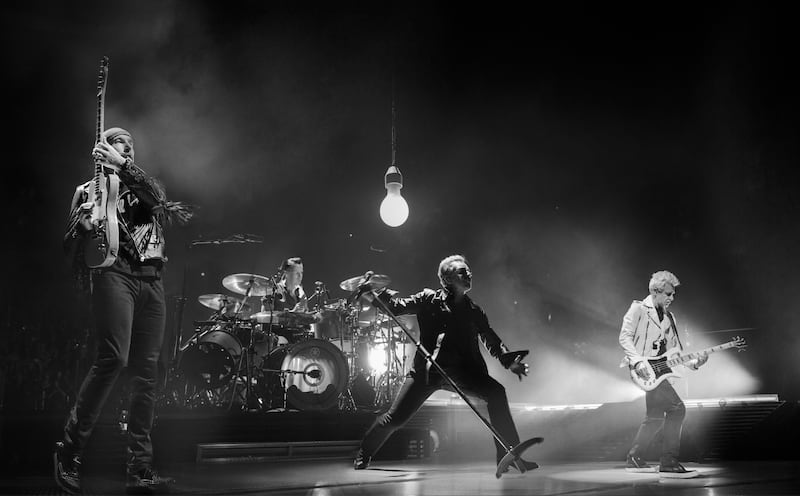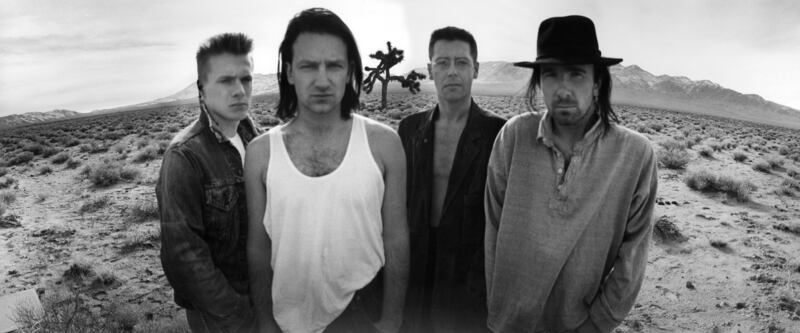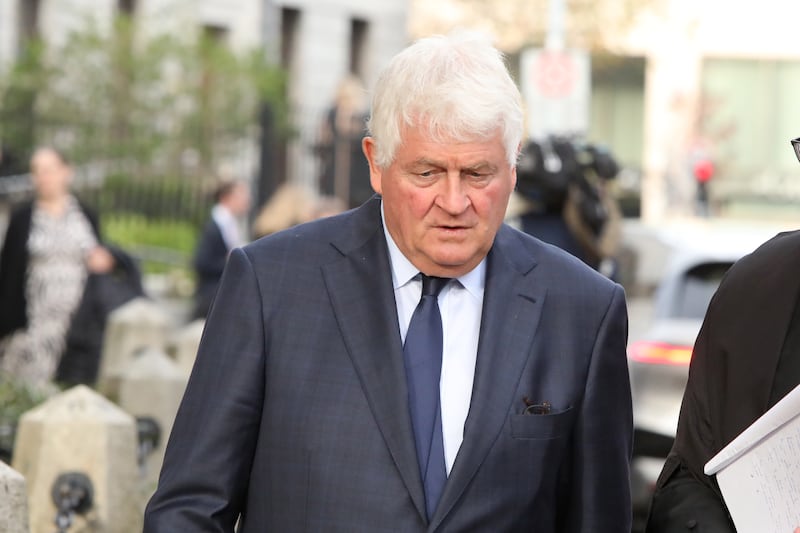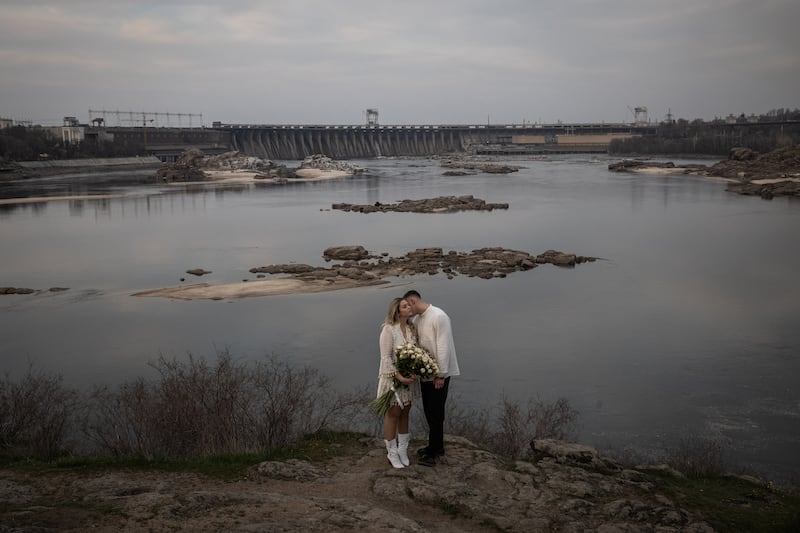Whether you’re pro-Bono or Edge-agnostic, you can’t deny that U2 are one of the most important rock bands of the past 40 years. But in Ireland they’re much more than that. They loom over Irish music in ways both positive and negative. Tomorrow, on St Patrick’s Day, they revisit 40 tracks from their catalogue with a new collection of rerecordings, Songs of Surrender. That release is accompanied by a Disney+ documentary in which Bono and the Edge lead a whiskery David Letterman on a tour of Dublin.
One question neither album nor film will answer is: what is U2’s best song? So we’ve taken on the task – and here present our top 20 U2 compositions. Consider our countdown a conversation-starter rather than the final word.
[ U2: Songs of Surrender – A cynical cash grab? Put your preconceptions asideOpens in new window ]
20
Lemon
1993
In the early 1990s U2 did what would have once seemed unthinkable and went wildly, unapologetically experimental. From this period came Lemon, a dazzlingly minimalist number that felt like an out-take from side one of the David Bowie album Low – which likewise featured Brian Eno – and was built around Bono’s childhood recollections of his mother, Iris, who died when he was 14. “I have very few memories of my mother because my father never talked about her after she died,” he wrote in U2 by U2. Then one day he was shown an old home movie of Iris. “The film was early colour and it looked extraordinary. It was a wedding, where she was the maid of honour in this beautiful lemon dress.” Years later, that image inspired the song.
19
Vertigo
2004
Arguably U2’s last great single. Incredibly, it also introduced a veteran rock band to an even wider audience by dint of gracing an Apple iPod ad. A booming rock number, it’s pedal-down U2 at their most crowd-pleasing. “It’s the way it connects with the crowd,” Bono would say, explaining that, though self-conscious about his singing, he loves the way his voice sounds on Vertigo.
RM Block

18
Desire
1988
U2’s first UK number-one single and the saving grace on the embarrassing misfire that was Rattle and Hum, their blues and Americana tribute album. The track has a double meaning: it’s U2 singing about their wish to be the biggest band in the world, but it’s also a criticism of televangelist preachers shaking down their audiences. The memorable video finds the Edge at the peak of his cowboy-hat-and-ponytail phase, a look he would wisely abandon in the next stage of their career (ditto for Adam Clayton’s denim vest, as sported in the video).
17
Until the End of the World
1992
The ghosts of Berlin Bowie and Talking Heads loom over this tortured chugger, the final song from U2’s finest album, Achtung Baby. The lyrics are inspired by the New Testament and Judas’s betrayal of Christ. One rumour is that the track flowed from a row between Bono and the Edge, with the verses coming to the singer in his father-in-law’s house. Which of the pair is the crucified saviour and which the traitor only Bono can say. It also featured in the Wim Wenders movie of the same name – though U2 were so happy with the recording that they insisted on putting it on their own album, too.
16
Bullet the Blue Sky
1987
U2’s sincerity has always been easy to mock. Yet only a group who utterly believed in rock’n’roll as an instrument of spiritual redemption could have written this breathtaking critique, from their album The Joshua Tree, of US military intervention in Central America. “When I explained to Edge what I’d been through in El Salvador, he was able to, with a nod to Jimi Hendrix, try and put some of that fear and loathing into his guitar solo,” Bono would say. “We strapped my feelings to the song Bullet the Blue Sky.”

15
New Year’s Day
1983
Has a heart ever been worn so raggedly upon a sleeve as on U2’s salute to Lech Walesa, the leader of Poland’s Solidarity movement? This is an early example of U2 singing their truths from a figurative mountaintop – and daring cynics to laugh. Some did, but the giggles were drowned out by the sheer force of Bono’s manifest destiny. There is, though, an amusing wrinkle: the bass line is the result of Adam Clayton’s attempt to cover Visage’s gothic pop song Fade to Grey.
14
Pride (In the Name of Love)
1984
This soaring tribute to Martin Luther King came together as U2 were sound-checking in Hawaii. Bono described the lyrics as a “simple sketch”, though the rest of the band would convince him to leave them as they were. In the studio the big addition was Chrissie Hynde on backing vocals. It’s both simple and overblown, punk and pretentious: early U2 in a nutshell.
13
Out of Control
1979
Featured on U2’s first release, the U2·3 single, Out of Control was chosen as the A-side by listeners calling into Dave Fanning’s RTÉ radio show. Powered by the Edge’s zinging new-wave guitar, the song captures the group at a moment of molten ambition. As Bono told Hot Press, “It’s about waking up on your 18th birthday and realising that you’re 18 years old and that the two most important decisions in your life have nothing to do with you – being born and dying.”
12
Gloria
1982
A haunting early entry in the canon, Gloria dates from the band’s early days (excepting perennial bad boy Adam Clayton) as devout Christians, with an outro sung entirely in Latin – “Gloria in Te Domine / Gloria exultate”, from the hymn Gloria in Excelsis Deo. “It’s so outrageous at the end, going to the full Latin whack,” Bono said. “Wonderfully mad and epic and operatic”. Yet for all its God-fearing qualities, it also has a pulsating energy, driven by the Edge’s postpunk guitar motif.

11
Ultra Violet (Light My Way)
1991
An underrated gem from Achtung Baby, this song features lyrics inspired by a Raymond Carver poem, Suspenders. It’s one of Bono’s most personal songs, in which he explores how a couple can reach a place of healing after inflicting emotional harm on one another. It’s got a “classic” Edge riff yet marries this to introspective lyrics and a slowly unfurling chorus of “baby, baby… light my way”. It’s the point at which 1980s and 1990s U2 collide like tectonic plates.
10
Numb
1993
The Edge should sing on more U2 songs. He doesn’t have the foghorn, dare-to-laugh power of Bono, but there is a sardonic, erm, edge to his delivery on Numb. This is U2 at their most zinging and minimalist – and subversive, with the drums sampled from Leni Riefenstahl’s Triumph of the Will. Talk about putting both hands on the third rail. Imagine how such a sample would go down today. The song is anything but fascist. Still, in 2023, how long would it take for U2 to be cancelled? It is also memorable for the video, in which the Edge finds himself jammed in the middle of a “foot sandwich”. Who said U2 don’t have a sense of humour? “The lyric came very quickly and tapped into many of the ideas behind Zoo TV,” the Edge said, referring to their sensory-overloading tour of the early 1990s, “the sense that we were being bombarded by so much information that you find yourself shutting down and unable to respond.”
9
Hold Me, Thrill Me, Kiss Me, Kill Me
1995
Never has so great a tune been so loathed by so many. U2 fans tend to have a visceral dislike of this gothic out-take from the band’s album Zooropa, which was repurposed for Joel Schumacher’s Batman Forever. It did reach number one (and number two in Britain). It was nonetheless nominated for a Golden Raspberry Award for worst original song.

8
Discothèque
1997
It’s got a disco-ball groove, the video features the band dressed as the Village People, and it frightened and confused U2’s American-heartland fan base. Has a U2 single ever had so much in its favour? Still, under the glitter, the tune circled around to Bono’s favourite theme: love and how difficult it is to sustain over the decades. “Discothèque is a riddle about love,” he wrote in U2 by U2. “Once you know that, it changes the way you hear the song. You can reach but you can’t grab it, you can’t hold it, control it, you can’t bag it.” Lots of opinions have been expressed about Discothèque and its promo film. Surely the best review comes from a fan commenting on YouTube: “Only U2 would have the cojones to make this video and risk looking completely ridiculous. Because of that confidence, the video ends up looking hip and effortlessly cool. You can see them barely able not to break out laughing. My favourite moment is when Edge dances awkwardly toward the camera and Bono nods his approval like this is the best thing he’s ever seen”.
7
The Fly
1991
Early in the recording of Achtung Baby, Bono came up with the persona of “the Fly”, a creation built around the “blaxploitation” sunglasses he cribbed off the group’s wardrobe man, Fintan Fitzgerald. However absurd the inspiration, it started a new chapter for U2. When the video dropped, people struggled to get their heads around a jaded, sardonic Bono and were shocked by the sound of the Edge cranking out industrial riffs somewhere between Sisters of Mercy and My Bloody Valentine. Three decades later it’s a lesson in how to rip it up and start again.

6
With or Without You
1987
The majestically brooding first single from The Joshua Tree – and, thus, the beginning of U2’s superstar period – is about Bono’s relationship with his wife, Ali, but also about his dynamic with the other three members of U2: the push and pull of needing your bandmates yet, at times, being fed up with them. He said: “That’s ... how I feel in U2 at times: exposed. I know that the group thinks I’m exposed and that I give myself away. I think if I do any damage to U2, it’s that I’m too open.”
5
11 O’Clock Tick Tock
1980
Someone should make a movie about the recording of U2’s second major-label single. It was made with the Joy Division producer Martin Hannett, a self-described mad genius. Flying to Dublin from Manchester, Hannett went down a rabbit hole with the tune and never came back. Adam Clayton’s bass was stitched together from individual notes isolated by Hannett and then painstakingly reassembled. At one point the producer fell over and shouted, “Jesus Christ! I’ve just hallucinated a gherkin!” U2 chose not to work with him on their debut album. But the record they assembled together was glorious, a presuperstar U2 at their rawest and edgiest.
4
Sunday Bloody Sunday
1983
“We’re trying to be The Who meets The Clash,” Bono said of their heartbreaking lament for the inescapable cycle of violence in the North. The song features perhaps the first great zigzagging Edge riff. It also has a cameo from the future Waterboy Steve Wickham, who met the Edge at a bus stop. “U2 had an amazing energy – I knew something special was going on,” the violinist would say. “I had been aware of them for a while. I also had a hard neck, and one day I saw Edge at a bus stop. I walked up and said, ‘Hey, man, do you need someone to fill in on the new record?’ That’s how I ended up on Sunday Bloody Sunday.”
3
Bad
1984
Bono’s epic lamentation for those claimed by Dublin’s 1980s heroin epidemic – and one of their most heartbreaking moments. Bad became famous when the group played an 11-minute version at Live Aid, in 1985, and Bono spontaneously hauled up an audience member to dance. It was heartfelt, but it also ensured U2 would be all over the headlines the next day – a contradiction that perfectly sums up the group.

2
I Will Follow
1980
This blistering early single suggested U2 might be something more than just another Dublin postpunk band. It was also one of Bono’s first meditations on grief and survival, drawing on his unresolved feelings about the death of his mother, just a few years earlier. “It’s coming from a very dark place,” Bono said. “It was literally coming out of a kind of rage, the sound of a nail being hammered into your frontal lobe.”
1
The Unforgettable Fire
1984
It started as a “soundtrack piece” the Edge had been mucking around with on piano. Next, U2 attended an exhibition at Chicago Peace Museum called The Unforgettable Fire, a collection of drawings by survivors of the United States’ atomic bombing of Hiroshima. And from there flowed one of their most cryptic moments, a feverish, enigmatic dirge that, almost 40 years later, still refuses to fully give up its secrets. We know all about loud U2 and populist U2. Here is something else: U2 waxing mysterious.























